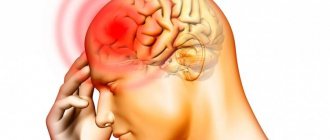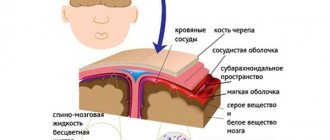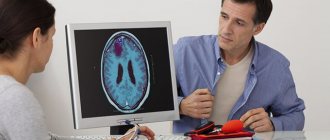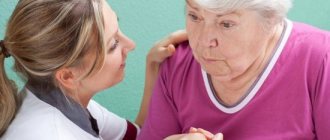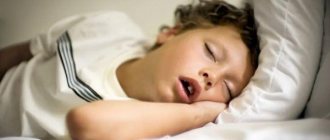Due to irritation of the meninges during infections of the central nervous system, cerebrovascular diseases, and traumatic brain injuries, meningeal syndrome occurs, which forms the basis of the clinical picture of any acute form of meningitis.
The localization of the pathological process and the age of the patient influence the severity of its individual components and the nature of clinical manifestations.
Symptoms of meningeal syndrome are an absolute indication for emergency hospitalization of the patient in a neurosurgical or neurological department, and in severe cases, in the intensive care unit of a hospital, since this is a very dangerous condition that is life-threatening.
Meningeal syndrome
Meningeal (meningeal) syndrome is a common pathology encountered by neurologists, infectious disease specialists, pediatricians, therapists, otolaryngologists and many other specialists. The syndrome gets its name from the Latin term “meningea,” which refers to the membranes of the brain. In cases where meningeal syndrome is caused by irritation of the cerebral membranes without their inflammatory changes, the definition of meningism is used in medical practice. The peak of active study of pathology occurred at the end of the 19th century; various authors proposed numerous specific symptoms of the disease that are still used today. Meningeal syndrome is observed at any age without gender preference. In elderly patients, the clinical picture is blurred.
The importance of correct diagnosis
Meningeal signs in neurology are important for correct diagnosis. Their manifestation most often indicates inflammation in the meninges. Meningeal signs may indicate serious illnesses such as:
- meningitis;
- severe purulent otitis media;
- sepsis of various origins;
- intracerebral hemorrhage;
- soft tissue abscess in the cervical region;
- TBI and back injuries;
- tumor disintegration.
Every qualified physician must be able to recognize these signs in order to correctly diagnose the disease and prescribe adequate treatment. Any symptoms indicating an inflammatory process in the meninges are grounds for a full examination of the patient.
Causes of meningeal syndrome
Etiofactors are many intracranial and multisystem pathological processes. Most often, meningeal syndrome provokes inflammation of the meninges (meningitis), subarachnoid hemorrhage, and traumatic brain injury. In accordance with the effect on the cerebral membranes, etiological causes are divided into two main groups - inflammatory and non-inflammatory lesions.
Inflammatory lesions:
- Bacterial
. Nonspecific - caused by meningococcal infection, Haemophilus influenzae, streptococci, pneumococci, in newborns - salmonella, E. coli. Specific – occurring when tuberculosis and syphilis pathogens penetrate the membranes. - Viral
. In 75% of cases, they are provoked by enteroviruses, less often by the Epstein-Barr virus, arenavirus, herpes infection, and tick-borne encephalitis virus. - Fungal
. The main pathogens are cryptococci, candida, aspergillus, histoplasma. They cause serous inflammation of the membranes with petechial hemorrhages. - Protozoans
. Observed in cases of toxoplasmosis and malaria.
Non-inflammatory lesions:
- Hemorrhages in the membranes of the brain
. They may occur as a result of acute cerebrovascular accident, severe arterial hypertension, head injury, or cerebral vasculitis. - Intracranial hypertension
. Develops as a result of hydrocephalus, space-occupying formations (brain tumor, intracranial cyst, abscess, intracerebral hematoma). - Intoxication
. Exogenous – paint and varnish production, substance abuse, alcoholism. Endogenous – uremia, hypoparathyroidism. - Neurotoxicosis
in common infectious diseases (influenza, typhus, dysentery, ARVI). - Carcinomatosis
is the infiltration of the cerebral membranes by tumor cells during various oncological processes, including leukocyte infiltration in neuroleukemia.
Assessment of neuropsychic development of children
The general level of neuropsychic development reflects the degree of maturation of the central nervous system. Timely detection of deviations allows for correction of neuropsychic development in the early stages.
The integral assessment of the level of mental development is the coefficient of development (QD).
where VPR is the age of mental development, KA is calendar age. VPR reflects the level of mental development of the child and is the arithmetic average of the child’s skills and abilities
for each indicator of the main lines of development. The QD value is assessed using table D. Wechsler, 1965.
Estimation of QD value (according to D. Wechsler, 1965)
Neuropsychic development is considered normal for a child in the first years of life, which lags behind the passport level or is ahead of it by one epicrisis period: up to 1 year of age - 15 days, at the age of 1-2 years - 3 months, 2-3 years - 6 months .
If a delay is determined by more than 2 epicrisis periods, it is necessary to exclude pedagogical neglect, diseases of the nervous system and others.
To establish the epicrisis period, the neuropsychic development of children is assessed based on the main lines of development.
For children in the first half of life
- this is the formation of auditory and visual indicative reactions, positive emotions, limb movements, general motor skills, preparatory stages of active speech and skills.
At the age of 6 to 12 months, the development of general movements, understanding of speech, active speech, actions with objects, abilities and skills that manifest themselves in the process of children’s communication with each other are assessed.
In the 2nd year of life, the main indicators are: development of understanding and active speech; sensory development, games and actions with objects; further development of motor activity, skills and abilities.
At the age of 2 to 3 years, the main indicators are: active speech, sensory development, participation in games, constructive and visual activity, motor activity.
from 3 to 7 years
They use data from observations of the child’s behavior during various regime moments, during in-depth medical examinations, as well as the characteristics of the teacher. In this case, the main indicators are motor development and visual coordination, speech development, cognitive activity, and socio-cultural development.
Meningitis is an inflammation of the membranes of the brain and spinal cord, affecting the soft arachnoid tissues and the cerebrospinal fluid circulating between them. Also, the development of pathology can affect the roots of the cranial nerves. The infectious disease is widespread throughout the world, especially in temperate geographic areas.
The anomaly is transmitted through the nasopharynx, so winter and early autumn are a more dangerous time of year for infection. The course of the disease can take the form of sporadic (irregular) or epidemic endemic. Most often it occurs in the first year of life, and recedes after four years. The next increase in infection occurs at the end of adolescence.
Pathogenesis
Meningeal syndrome has two development mechanisms. The first, the inflammatory process, occurs in response to the penetration of infectious agents. Infection of the cerebral membranes occurs through contact (with open head injury, osteomyelitis of the skull bones), lymphogenous, perineural, and hematogenous routes. The introduction of pathogens through the bloodstream is more often observed in the presence of foci of purulent infection (sinusitis, purulent otitis, mastoiditis). With encephalitis, inflammation in the brain substance spreads to the tissues of the membranes with the development of meningoencephalitis. The second pathogenetic mechanism is irritation of the meninges. An irritating effect is caused by accumulations of blood during subarachnoid hemorrhage, increased intracranial pressure, toxic substances entering the body from the outside or resulting from dysmetabolic processes, the activity of pathogenic microorganisms, and tissue decay in cancer.
Classification and characteristic symptoms
- The disease differs according to the location, time of course and cause of occurrence: Primary and secondary forms of pathology are determined by frequency; the initial form is based on neuroviral and bacterial causes. Repeated is a complication of influenza, syphilis or tuberculosis.
- The condition of the cerebrospinal fluid is characterized by purulent, hemorrhagic, serous meningitis.
- Period of course: reactive, acute and chronic.
- Form of infection: hematogenous, contact, perineural, lymphogenous, traumatic brain injury.
- Generalized and limited are determined along the border of the affected area.
A febrile illness occurs with a number of symptoms, the totality of which is called meningeal syndrome. Accompanied by increased intracranial pressure and irritation of the spinal roots. It can occur simultaneously with pathology of the autonomic nervous system. Main manifestations in children:
- hyperthermia (high body temperature);
- photophobia;
- reaction to loud sounds (shuddering, crying);
- vomiting not associated with food intake;
- rash on the skin;
- seizures of epilepsy cannot be excluded.
Symptoms of meningitis in a child depend on the type of pathology and the age of the patient.
In infants
The main cases of development of the disease occur in the first year of life. Diagnosis is difficult due to mild manifestations and the incompetence of the mother, who does not attach importance to the first signs. The serous form does not appear in infancy. Viral meningitis affecting the membranes of the brain in infants is expressed by the following symptoms:
- refusal of food and water, regurgitation, diarrhea;
- periodic vomiting;
- yellowing of the skin, rash;
- the occipital muscles are toned;
- weakness, drowsiness, hypotension (lethargy);
- temperature increase;
- convulsions;
- tension of the cranial fontanel;
- hydrocephalic cry.
Also, symptoms of meningitis in a child are characterized by agitation when touched, irritation, and constant crying. When lifting a baby by the armpits, the head involuntarily throws back and the legs tighten (Lessage's symptom).
In babies
From one to 5 years, the infection can be bacterial or caused by the ECHO and Coxsackie viruses. The clinical picture is accompanied by pronounced symptoms, the disease develops quickly. If during the inflammatory process purulent fluid forms in the brain, serous meningitis is determined with characteristic symptoms:
- A sharp jump in body temperature to 40 degrees, chills.
- Difficulty in swallowing.
- Rash on the oral mucosa.
- Strong stabbing or pressing sensations in the head with phases of pain crises.
- "Brain" vomiting not associated with food intake without previous nausea.
Symptoms of meningitis in children are complemented by pallor of the skin and pathological muscle reflexes to certain movements.
During adolescence
School-age children can verbally describe their condition, which makes diagnosis easier. Inflammation of the meninges manifests itself quickly, with characteristic signs, hyperthermia up to 40 degrees and toxic syndrome (vomiting). Then the following symptoms of meningitis in adolescents are added:
- redness of the throat mucosa;
- swallowing is difficult;
- disturbance of consciousness accompanied by delirium;
- numbness of limbs, convulsions;
- navicular abdomen due to painful contraction of the abdominal muscles;
- in severe cases, severe backward bending of the body due to generalized spasm in the back;
- redness and swelling of the face, rash on the skin and mucous membranes;
- yellow color of the skin and whites of the eyes;
- joint pain, swollen lymph nodes;
- changes in breathing rhythm and heart rate.
The disease is accompanied by severe headache, impaired motor functions, which are expressed by tonic spasms of individual muscle groups, involuntary movements or partial paralysis due to paresis of the cranial nerves.
Symptoms of meningeal syndrome
Hemorrhoids kill the patient in 79% of cases
The meningeal symptom complex is formed by cerebral manifestations and meningeal symptoms themselves. Intense diffuse cephalalgia (headache), vomiting without preceding nausea is typical. Vomiting is not accompanied by relief of the patient's general condition. In severe cases, agitation is observed, followed by apathy, epileptic seizures, hallucinations, depression of consciousness to the point of stupor, coma are possible. The pathognomonic symptoms that characterize meningeal syndrome include three groups of symptoms: signs of hyperesthesia, muscle-tonic manifestations, and pain phenomena.
Hyperesthesia is manifested by increased sensitivity to sounds (hyperacusis), light (photophobia), and touch. The most common muscular-tonic symptom is rigidity (hypertonicity) of the neck muscles, which is detected when the patient attempts to passively flex the patient’s head. An increase in muscle tone causes a typical position: lying on your side with an arched back, head thrown back, limbs bent and brought towards the body (“pointing dog pose”). Reactive algic symptoms include pain in the eyes when moving and pressing on the eyelids, pain in trigger points of the trigeminal nerve, Kehrer points on the back of the head, and in the cheekbones.
Heat
The patient's temperature rises sharply - up to 40°C - and fever begins. This is one of the first signs of meningitis. An unfavorable symptom is body temperature below normal. There is also a localized form of meningitis, when the infected person himself is not sick, but is a carrier of the infection, or the disease is mild, resembling ARVI. Then the temperature reaches 38°C. Doctors recommend going to the hospital even if you suspect localized meningitis, as the disease can become severe.
Photo: spinoff.com
Diagnostics
Meningeal syndrome is diagnosed by specialists in the field of infectology, pediatrics, neurology, and therapy. When examining, pay attention to the presence of meningeal posture, hyperesthesia, pain and tonic phenomena. Hypertonicity of meningeal origin is differentiated from muscle tension accompanying myositis and radiculitis. In the neurological status, characteristic changes in the reflex sphere are determined: revival of reflexes, followed by their uneven decrease. If meningeal syndrome is associated with damage to the brain substance, then a corresponding focal neurological deficit is detected (pyramidal insufficiency, aphasia, cerebellar ataxia, facial nerve paresis). There are more than 30 clinical symptoms that help diagnose meningeal syndrome. The most widely used among neurologists and general practitioners are the following:
- Kernig's sign
- with the patient lying on his back, the lower limb is passively flexed at the hip and knee joint. Subsequent attempts by the doctor to straighten the leg at the knee are impossible due to tonic contraction of the shin flexor muscles. - Brudzinski's symptoms
- in the supine position, there is an involuntary pulling of the lower extremities towards the abdomen when bending the patient's head (upper), pressing on the pubis (middle), checking Kernig's sign (lower). - Edelman's sign
is extension of the big toe when examined using the Kernig method. - Netter's sign
- in a sitting position with legs extended in bed, pressing on the knee of one leg causes the other to bend. - Kholodenko's symptom
is bending of the knees when the doctor tries to lift the patient by the shoulders. - Guillain's sign
- in the patient's supine position with straightened legs, compression of the muscles of the anterior surface of one thigh leads to flexion of the second leg. - Lessage's symptom
- when holding a child in the air in a vertical position by the armpits, the legs are pulled towards the stomach. Characteristic for young children.
The most important role in the diagnosis of meningeal syndrome is played by lumbar puncture. It is contraindicated in cases of severe intracranial hypertension, the danger of mass effect, and is carried out after excluding these conditions according to ophthalmoscopy and echoencephalography. Cerebrospinal fluid examination helps establish the etiology of the syndrome. Turbid cerebrospinal fluid with a predominance of neutrophils indicates purulent, opalescent with an increased content of lymphocytes - the serous nature of the inflammation. An admixture of blood is observed with subarachnoid hemorrhage, cancer cells - with oncological lesions.
Meningeal syndrome is differentiated by etiology. Verification of the final diagnosis is achieved using bacteriological and virological examination of cerebrospinal fluid, blood culture, PCR studies, electroencephalography, and MRI of the brain.
Hardening of the neck muscles
The muscle tissue located in the back of the head begins to harden with meningeal syndrome. This problem arises due to an abnormal increase in their tone. The occipital muscles are responsible for straightening the head, so the patient, due to its rigidity, cannot calmly bend his head, since along with this movement the upper half of the body is arched.
For people suffering from meningeal syndrome, a certain position is characteristic, in which the intensity of pain decreases:
- Hands pressed to the chest;
- Body arched forward;
- Intracted abdomen;
- Head thrown back;
- Lower limbs raised closer to the stomach.
Treatment of meningeal syndrome
Full-blown meningeal symptom complex requires treatment in a hospital setting. Therapy is carried out differentiated, taking into account the etiology and clinical manifestations, and includes the following areas:
- Etiotropic treatment
. For bacterial etiology, antibiotic therapy is prescribed with broad-spectrum drugs, for viral etiology - with antiviral agents, and for fungal etiology - with antimycotics. Detoxification and treatment of the underlying disease are carried out. Before the pathogen is identified, etiotropic therapy is carried out empirically, after clarification of the diagnosis - in accordance with the etiology. - Decongestant therapy
. Necessary to prevent cerebral edema, aimed at reducing intracranial pressure. It is carried out with diuretics and glucocorticosteroids. - Symptomatic therapy
. Aimed at relieving emerging symptoms. Hyperthermia is an indication for the use of antipyretics, arterial hypertension - antihypertensive drugs, repeated vomiting - antiemetics. Psychomotor agitation is relieved by psychotropic drugs, and epileptic paroxysm is relieved by anticonvulsants.
Prognosis and prevention
In most cases, timely and correct treatment leads to the patient’s recovery. Residual effects may be observed for several months: asthenia, emotional lability, cephalgia, intracranial hypertension. An unfavorable outcome is meningeal syndrome, which accompanies a severe disease of the central nervous system, a fulminant course of the infectious process, and oncopathology. Prevention of meningeal syndrome includes increasing immunity, preventing infectious diseases, injuries, intoxications, and timely treatment of cerebrovascular and cardiovascular pathologies. Specific prevention is possible against meningococcal and pneumococcal infections.
Features of determining changes in pediatric patients
In children, meningeal symptoms are checked according to age. There are several main meningeal signs, these are the symptoms:
- “planting”
- when trying to sit a child with straight legs, he bends them or tilts his body back with support on his hands;
- Lessage
is relevant for children in the first year of life: the baby is lifted, holding the armpits, while the legs are pulled up to the stomach and remain in this position (normally, children move their legs, simulating a search for support); - Lesage-Abrami
- children are drowsy, quickly lose weight, they have disruptions in cardiovascular function;
- “kissing the knee”
is characterized by the inability to touch the knees with the mouth while sitting.
In addition, in patients of early childhood, bulging of the large fontanelle is noted.
In addition to the listed symptoms included in meningeal syndrome, there are many other features that in some cases are detected in patients with irritation of the meninges. These are the symptoms:
- Lafora
- sharpening of facial features; - Bickel
- a patient with bent arms for a long time;
- Blankets
- the patient does not allow the blanket to be pulled off, which is typical even for patients with impaired consciousness; - Lichtenstern
- tapping on the forehead provokes shuddering and increased pain; - Mann-Gurevich
- deterioration when opening the eyes or moving them, accompanied by fear of light and sound;
- Mendel and Mandonesi
- the appearance of a painful grimace when pressing from the inside on the front wall of the ear canal on both sides and when pressing on the eyes; - Signorelli, Kerera, Kullenkampf:
severe pain when palpating the exit points of some cranial nerves; - Levinson
- opening of the mouth when trying to touch the chin to the chest.


